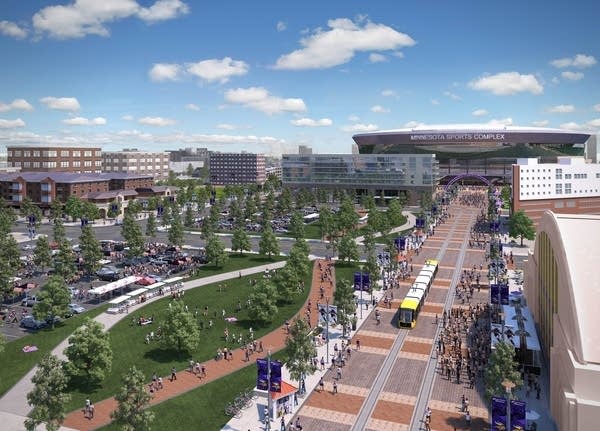How will Vikings stadium fit into urban landscape?

Now that a Vikings stadium is approved, what should be done to make sure it 'fits' into Minneapolis' urban landscape?
Charles Landry, a well-known British consultant, spoke with The Daily Circuit about the ways cities unleash creativity to make themselves economic and cultural magnets.
Landry has spent a week touring the Twin Cities and will offer his final recommendations to regional leaders on Friday; we'll also hear his thoughts on the new light rail line -- and his belief that the line is an amazing opportunity to bridge the area's ethnic populations.
ON STADIUMS
Create a More Connected Minnesota
MPR News is your trusted resource for the news you need. With your support, MPR News brings accessible, courageous journalism and authentic conversation to everyone - free of paywalls and barriers. Your gift makes a difference.
Charles Landry: In general, stadia neutralize the space around them and kill the city- as an urban construct. Obviously it makes money internalized, which is why I've done a lot of work around that, especially convention centers. I was doing some work in Sydney around that; I've been looking a lot at football stadia in Britain. And what you find -- Arsenal stadium, Chelsea stadium, as an example, both wrap housing around them in a way so that the stadium is slightly disguised and so the thing around it - the setting - feels like it's alive in a day-to-day sense because of course, an event is only on here and there.
So really, the question is to think through in a physical sense - how the stadium is helping foster that sense that we're in a city, rather than there's a point occassionally where an event happens.
Then, when you have these other facilities around it, wrapped into the fabric of the stadium itself, then it really begins to contribute to the city. I think the basketball stadium in Washington does that very well. You can hardly feel the stadium's there - it is there, I've been there, it's very large - but outside there are so many other things to do wrapped around the fabric itself, so it's not an isolated satellite that's come down from space.
Tom Weber: That criticism is widely held with the current stadium, the Metrodome. In meeting with officials here, have you gotten the sense the desire is there to do what you're talking about, or are we just going to build another Metrodome?
CL: I didn't feel there was the urgency to rethink this, which one can rethink. It's not an either/or, it's how can we maximize the opportunity for the city and the football crowd? And that's where a city needs to say 'these are our principles. We've agreed you can have a stadium - how are you going to help make your stadium make the city feel better, in the sense I'm talking about?'
What Minneapolis must not do is build the past - if it builds the past, it will create a dead zone around it. And anyway, it makes money if you think about it properly.
